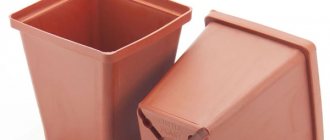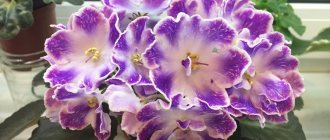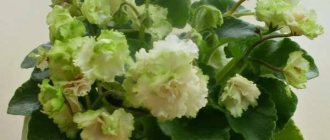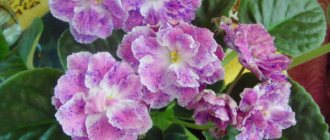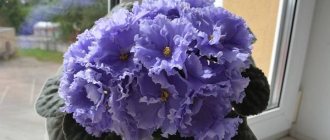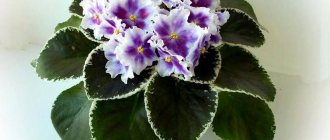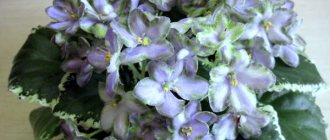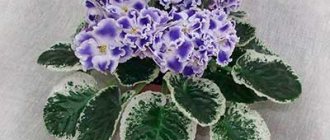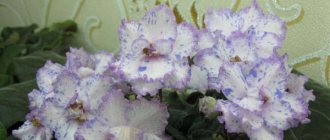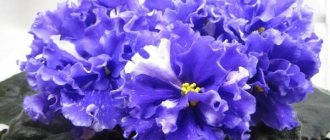Many amateur flower growers are not too seriously interested in a new variety in their collection; it is only important that they are satisfied with the external parameters and study the general rules of care.
When a more serious gardener approaches the selection of a new individual for his collection, he
studies in more detail all the nuances of interest .
Among them is an accurate description of the variety, for comparison and identification of possible sports. In addition, it is important to study the care features , which, depending on the variety, may differ slightly from those that are usually used for this species. In the article you will see a photo and description of the variety.
Violet AE-Armageddon (E. Arkhipov)
Mysterious violet Armageddon.
AE-Armageddon belongs to Uzambor violets , from the genus of hybrid Saintpaulias, class Gesneriev. E. Arkhipov was involved in breeding the variety, as evidenced by the prefix AE in the name.
The rosette belongs to large standards, and in good conditions grows to 50-55 cm in diameter . Sheets:
- Large;
- On cuttings;
- Reach 15 cm in length.
color :
- Uniform;
- Deep green.
Flowers are often lost against the background of such a rosette .
quite large in diameter (up to 5 cm), but gets lost on a large bush. A double or semi-double flower in the first days pleases with the brightness of its color, which quickly fades.
The main color of the petals is purple-black , with clear polka dots of light fantasy.
are quite common for this variety . In most cases, the flowers are solid, dark (primary) color, or light as peas.
Important! Sometimes the first flowering may not correspond to the varietal characteristics, but this does not make the individual a sport. Flowering may be affected by the characteristics of the content.
Methods of propagation of the variety
It is better to propagate Dolce Vita violets using the leaf method. The cuttings are cut at an angle and left for 30 minutes until completely dry. After this, it is placed in a dark jar of water or buried in the ground. In the first case, the water must be melted, for example, when defrosting a refrigerator.
Dolce Vita violet can be propagated by leaf rooting.
The bubble with the leaf is located in a bright place without drafts or direct sunlight. After 30-40 days, the first roots can be observed. When their length reaches 2-3 cm, the leaves are transplanted into small pots with an earthen mixture.
The seedlings are buried into the soil no more than 1-2 cm. To provide support for the young plant, it is tied to a straw or wooden stick. The container with the flower is covered with film and again sent to a bright room. The film cover can be removed after a couple of weeks.
When sprouts 4 cm high appear near the cuttings, they are separated and transplanted into small pots with a diameter of 4 cm. When the root system completely fills the space of the pot, the violets are transplanted into larger containers.
If leaf cuttings are germinated in soil, then for these purposes a special soil composition is taken: coarse sand, peat, leaf soil in a ratio of 4:1:2, with the addition of birch charcoal (1 spoon per 1 liter of substrate). In soil, cuttings take root more slowly than in water, but they tolerate replanting more easily and adapt faster.
Caring for a plant at home
Content requirements
Like all Saintpaulias, AE-Armageddon prefers bright, diffused light . Grows well on a windowsill where there is no direct sunlight. With additional light, for example under a lamp, the rosette can reach 55 cm in diameter.
Like many violets, this variety loves diffused light.
It is recommended to maintain the temperature within 24° C, deviation plus or minus 2°. At the same time, AE-Armageddon reacts well to natural temperature conditions; it is only important to prevent the temperature from dropping :
- Below 16֯;
- And also increases - above 26֯.
Attention! Like all Saintpaulias, the variety tolerates increased temperatures better (subject to frequent watering) than hypothermia.
It is recommended to keep the air humidity in the room at a suitable level - about 60% . If the water level in the air near the violet is high, rotting of parts of the plant (roots, leaves, growing point) occurs.
If there is excessive dryness, especially in the heat, the leaves first wither , and then the growing point may simply burn out, but the plant can be saved by frequent watering.
Watering and fertilizing
The AE-Armageddon variety responds well to different types of watering :
- Classic - in a tray or under the leaves (avoiding contact with the leaves and growing point). The procedure is carried out as needed, when the earthen clod dries out, about once a week, at a temperature of 25°. For this type of irrigation, fertilizing is carried out through irrigation (about once every 2 weeks), and the dosage of mineral fertilizer is reduced by half, relative to that stated by the manufacturer;
- Wick – the water is in a container under the pot, and the plant draws it through the wick, lowered by the lower drainage hole. In this option, water is constantly in the container and fertilizer as well. The concentration of mineral fertilizer is reduced by 7-8 times relative to that declared by the manufacturer.
The variety must be watered as the soil dries.
Rejuvenation, transplant
The variety needs frequent replanting, both during growth and after. Typically, the procedure is carried out once a year (sometimes more often) - for an adult plant and, as necessary, for a growing rosette. Depending on the purpose of the transplant, it is carried out in two ways :
- Transshipment - for a growing individual, in order to enlarge the pot. To do this, prepare a new pot, a little larger than the old one, a substrate and the plant itself. Next, simply transfer the rosette, along with the old soil, into a new pot and sprinkle it in a circle with new soil;
- Replanting with soil replacement - during a planned replanting, or in case of illness. The tools are the same as for the first option. Saintpaulia is taken out from the flowerpot, all soil is shaken off, damaged roots are removed, and the lower leaves are cut off. During planting, the stem is buried, placed strictly in the center and covered with soil, avoiding contact with the leaves.
Often, the method of replanting with soil replacement is used for rejuvenation , in which several rows of leaves are cut and, if necessary, the stem is cut from below to the level of living roots.
faded leaves and peduncles are trimmed as necessary , otherwise they:
- They pull juice from the outlet;
- And they spoil the appearance.
Important! To prevent excessive growth of the rosette, it is often replanted, but fertilizers and artificial lighting are not used.
For planting and replanting Saintpaulias, it is important to use suitable soil, it can be :
- Buy in store;
- Or make it at home.
The substrate is made up of equal parts :
- Peat;
- Ground;
- And perlite;
- And also add one third of the sphagnum moss.
You can collect the soil yourself at home.
For wick irrigation, only peat and perlite are used in equal parts .
Reproduction
Like all Saintpaulias, propagation is carried out vegetatively (to obtain new varieties - by seeds):
- Leaf cuttings - use material from the second or third row. Rooting is carried out in water, soil or moss. After the babies appear and grow to 4-6 leaves, after which they are seated;
- Stepchildren - stepchildren are planted with their own roots, or if there are 4-6 leaves, they are rooted like a leaf cutting;
- Peduncles – they are rooted in the soil under the film.
Most often, violets are propagated by leaves.
Bridal violet (K. Morev)
History of the variety
Podvenechnaya violet is a selection of Konstantin Morev, who is known not only as a domestic breeder, but also a student of Boris Makuni, who is called the “father” of Russian violet selection.
Among violet growers they tell a story that the name of the variety “Podvenechnaya” was given to the nameless seedling by Boris Makuni himself .
When Makuni saw the first flowering of the seedling, he said that the color reminded him of the color of the dress in which his wife Tatyana Nikolaevna got married. So the nameless seedling received the beautiful name “Podvenechnaya”.
Photo and description of the variety
Hybrid Saintpaulia Podvenechnaya (K. Morev) is an Uzambara violet of the Gesneriev family.
Violet Moreva Podvenechnaya – standard. Rosette of the variety :
- Neat;
- Smooth.
Leaves of a flower:
- Dark green color;
- Slightly inclined downwards.
Unusual violet Bridal.
Round large, simple and semi-double white star flowers , with a pink spot on each petal, are charmingly complemented by blue-violet fantasy touches on the delicate pink petals.
There is a white eye in the center of the flower. Depending on the conditions of detention, the white spot in the center of the flower can :
- Change size;
- Or disappear completely.
Flowering is always different:
- Some are lighter, with a lot of white;
- It's darker.
And the fancy strokes on the petals are also different every time .
This variety always blooms differently.
Attention! The variety blooms readily, but only reveals the full potential of cap flowering only by the third flowering.
Variegation, imprints
A variety of standard green color without variegation.
Sports
The “Podvenechnaya” violet variety is of extraordinary beauty, but the sports varieties are also beautiful. For the charming color of the petals, each sport can be considered special . There are violets of this variety that have gone into pink sport in the summer heat, as well as children that have faded due to a mutation not according to the varietal characteristics of the maternal rosette.
There are terry sports and, on the contrary, with simple petals - stars.
Terry sport of violets.
Dark sport - semi-double blue stars, with pearlescent petals and a white border.
Dark sport of Saintpaulia.
There are also amazingly colored sports that combine both varietal flowering and pink and white sports, along with white or blue flowers.
Occasionally, the variety exhibits an unusual sport.
Sports can manifest themselves in different ways.
Sport – pink with fancy touches , without a white border or spot in the center.
Sometimes there is pink sport.
Chimeric sport "Podvenechnaya".
There are also chimeric sports.
Reviews
Marina. “I bought the baby AE-Armageddon. She grew so sharply that I was a little scared that something might be wrong. But then I looked for information and everything fell into place. I love big violets, so I let it grow. But after the first flowering I regretted it; it was worth limiting its growth. Flowers on such a huge scale look funny, they seem so small.”
Olesya. “I saw AE-Armageddon blooming and bought a leaf; when the rosette grew, I was looking forward to flowering. When the first buds appeared, there was disappointment, because they were lost against the background of large leaves.
I gave her a second chance, but even the second time the flowers seemed very small relative to the rosette.
So I just gave it to my friend. In favor of the variety, I would like to note the beautiful color of the flowers.”
Features of flowering, growth and reproduction
Children grow and develop well at home. With frequent replanting and natural light it blooms early ; if fertilizers are used, the first buds appear even earlier.
Attention! An adult bush can be obtained in 11-13 months.
There are not many buds on the peduncles (2-5), and the peduncles themselves are :
- Sturdy;
- And upright.
Cap flowering is not uncommon for this variety, but it is more of a bouquet than a cap. The buds last a long time, about two to three weeks . In the first days, up to a week, the color is bright and fancy, then the petals gradually lighten to the shade of peas.
Despite the fairly good size of the flowers, 5 cm in diameter, they seem small on a huge rosette.
Color is slightly affected by temperature , for example:
- In hot weather, fancy peas sometimes disappear;
- And in cool weather, some buds may lighten.
Reproduction is possible by all vegetative methods . It is important to consider that with leaf cuttings the number of sports increases.
Violet LE-Greenland
Gesneriev family, genus of Hybrid Saintpaulias, Usambara violet LE-Greenland . Bred by breeder E. Lebetskaya. Below you will find a photo and description of the variety.
Mysterious violet LE-Greenland.
The flowers are shaped like a semi-double star , slightly cup-shaped and quite large in size. The color of the petals is white, sometimes a little dirty, with a light green border and pronounced waviness along the edge of the petals.
The rosette is smooth, usually symmetrical, and does not tend to pull leaves or hug the pot. Sheet variety :
- Heart-shaped;
- With a clear vein pattern;
- Small teeth along the edge;
- And pointed at the tip.
The color of the leaves is variegated, has a dark green base tone and white-pink variegation, which sets off the white flowers well.
Attention! The variety almost does not react by changing color to climate changes, and is also a rarity in sport, which is why there are no registered variants.
Features of flowering, growth and reproduction
The variety develops well at home and grows at an average speed. A mature rosette can be obtained in about a year, with the first flowering often occurring earlier.
Symmetry is easily formed even on a windowsill, but for this it is necessary to periodically unfold the pot.
Reproduction of LE-Greenland requires a little effort . Propagation by peduncles is not suitable for this variety, since quite often the variegation of the leaves is not transmitted.
When using leaf cuttings, the chance of getting completely green leaves is small, but still possible. The most reliable option can be considered the separation of stepchildren, but bushes are rarely divided.
Unlike many white Saintpaulias, LE-Greenland:
- Doesn't swim in hot weather;
- And it does not lose its light green border in cool conditions.
But in rare cases, there is still a slight darkening of the main part of the petals, to an off-white, slightly light green hue.
The peduncles are quite thin, sometimes a little long, reaching towards the rosette[/anchor] forming a beautiful cap. When there are a lot of flowers, they can fall on the leaves, this is caused by their size and splendor.
Flowering is very short, drying is uneven and unaesthetic, one petal at a time withers.
Reviews
Review 1 I really liked Saintpaulia LE-Greenland. My beauty blooms in a fairly pure color, white is pure and without shades, and the border is not very wide.
My rosette is a little spreading, the cuttings of the leaves are elongated, but I think this is due to the youth of the bush and the darkness on the windowsill.
Review 2 I bought a blooming LE-Greenlandia, I am very pleased with it. It bloomed for a long time, but now it has faded quite ugly, as if the petals on the flower are burning, one by one, and the buds do not last long.
When propagating by leaves, to my regret, I received several non-variegated individuals. For now I left them at home, I want to see how they bloom.
The variety has many positive reviews.
